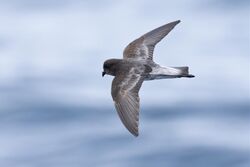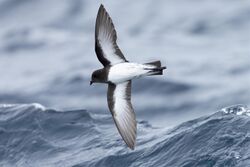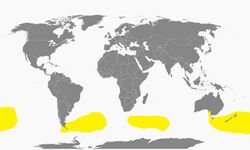Biology:Grey-backed storm petrel
| Grey-backed storm petrel | |
|---|---|

| |

| |
| Scientific classification | |
| Domain: | Eukaryota |
| Kingdom: | Animalia |
| Phylum: | Chordata |
| Class: | Aves |
| Order: | Procellariiformes |
| Family: | Oceanitidae |
| Genus: | Garrodia Forbes, WA, 1881 |
| Species: | G. nereis
|
| Binomial name | |
| Garrodia nereis (Gould, 1841)
| |

| |
| Synonyms | |
| |
The grey-backed storm petrel (Garrodia nereis) is a species of seabird in the austral storm petrel family Oceanitidae. It is monotypic within the genus Garrodia.[2] It is found in Antarctica, Argentina , Australia , Chile , Falkland Islands, French Southern Territories, New Zealand, Saint Helena, South Africa , and South Georgia and the South Sandwich Islands. Its natural habitat is open seas.[1] It is highly attracted to bright lights, especially in conditions of low visibility.[3]
Taxonomy
The genus Garrodia was created by William Alexander Forbes in 1881[2] and named after English zoologist Alfred Henry Garrod,[4] while the specific descriptor is an allusion to the Nereids, the sea nymphs of Greek mythology.[5]
Description
Grey-backed storm petrel is a small bird, 21-44 g in weight with a 39-40 cm wingspan. Like others in its family it is dark grey overall with a black head and belly, but it can be distinguished from other storm-petrels in its range by its light grey rump compared to the white rump on others. The Grey-backed petrel has a pale back, black legs, a square tail and a white belly.
Distribution
The grey-backed storm petrel has a distribution in the subantarctic in three disjunct populations, with one off of South America, on off of South Africa , and one off of Australia . It breeds in the Falkland Islands,[6] Chatham Islands, Gough Island, Crozet Islands, Kerguelen Island, the New Zealand Subantarctic Islands, and Fiordland on the New Zealand mainland.[7]
Behaviour
Grey-backed storm petrels are mostly solitary during the non-breeding season. They breed in large colonies from August to March, where they share parental duties.
References
- ↑ 1.0 1.1 BirdLife International (2018). "Garrodia nereis". IUCN Red List of Threatened Species 2018: e.T22729148A132660152. doi:10.2305/IUCN.UK.2018-2.RLTS.T22729148A132660152.en. https://www.iucnredlist.org/species/22729148/132660152. Retrieved 12 November 2021.
- ↑ 2.0 2.1 "ITIS Report: Garrodia". Integrated Taxonomic Information System. https://www.itis.gov/servlet/SingleRpt/SingleRpt?search_topic=TSN&search_value=174657.
- ↑ "Garrodia nereis (Gould). Grey-backed Storm-Petrel. Océanite néréide.", The Birds of Africa (Academic Press Limited), http://dx.doi.org/10.5040/9781472926982.0049, retrieved 2023-09-16
- ↑ Jobling (2010), p. 171.
- ↑ Jobling (2010), p. 268.
- ↑ "Grey-backed Storm-petrel Garrodia nereis". http://datazone.birdlife.org/species/factsheet/grey-backed-storm-petrel-garrodia-nereis/text.
- ↑ Miskelly, Colin; Bishop, Colin R; Stahl, Jean-Claude; Tennyson, Alan J.D. (June 2021). "Further evidence in support of grey-backed storm petrels (Garrodia nereis) breeding in Fiordland". Notornis 68: 177-181. https://www.researchgate.net/publication/361823672_Further_evidence_in_support_of_grey-backed_storm_petrels_Garrodia_nereis_breeding_in_Fiordland. Retrieved 30 October 2023.
Cited texts
- Jobling, James A. (2010). The Helm Dictionary of Scientific Names. London, UK: Christopher Helm. ISBN 978-1-4081-2501-4. https://archive.org/details/Helm_Dictionary_of_Scientific_Bird_Names_by_James_A._Jobling.
Wikidata ☰ Q1261174 entry
 |


